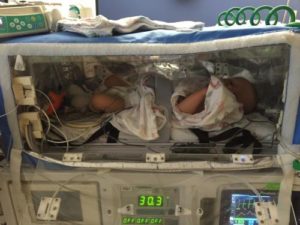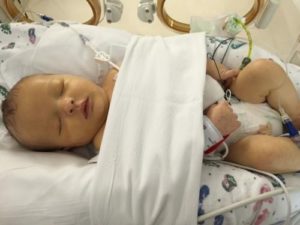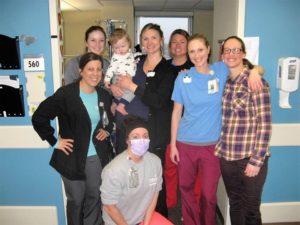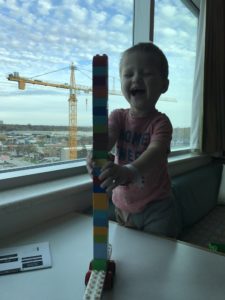David’s Story: A Journey through Two States
and a 9-Month NICU Stay
A lot was going on in Lindsay’s life at this time. She and John lived in Colorado Springs and were both civil engineers. They were preparing for a big move to Montana with their jobs and would be moving shortly after David’s birth.
“Our plan was to move a few weeks after David was born,” explains Lindsay. “All of my pregnancies had been normal, and David had a great 20-week scan, so we felt comfortable with the timeline.”
In the spring of 2016, as they were all packed up and coordinating their move, David would make his entry into the world just shy of 40 weeks or what would be considered full-term for a healthy pregnancy.
“I had a normal vaginal delivery, his scores looked great and I was able to breastfeed him right away,” remembers Lindsay. “But, about two hours later, he started throwing up something dark brownish- black. The mood changed right away, and he was whisked off to the Neonatal Intensive Care Unit (NICU) immediately. I wasn’t sure what was going on.”
At first, the doctors thought David had swallowed meconium while coming down the birth canal, something very common during a vaginal delivery. But, when David began throwing up all his feeds, the doctors decided to transfer David to Rocky Mountain Hospital for Children in Denver to do some more tests.It was at the Rocky Mountain Hospital where David would be diagnosed with Hirschsprung’s disease. This condition, seen most often in males, is a condition that affects the large intestine (colon) and causes problems with passing stool. The condition is commonly present at birth because of missing nerve cells in the muscles of the baby’s colon.
This condition normally affects only the colon, but in David’s case it affected all of his colon (large intestine) and also nearly all of his small bowel, something referred to as “near total intestinal aganglionosis.” David would go on to have two surgeries at Rocky Mountain Hospital. Unfortunately, his condition was not improving and he still didn’t have a functioning bowel.
At the same time, Lindsay’s job re-location was still in motion, but she and John would be reassigned from Montana to Omaha. This turned out to be a blessing in disguise. What Lindsay would come to learn was that Omaha was home to Children’s Nebraska and surgeons and physicians who were highly specialized in this disease.
“At five weeks old, we transferred David from Colorado to Omaha, and he was in really rough shape,” remembers Lindsay. “While we were moving and driving over to Omaha, David was also being transported and I met Children’s Transport Team when they arrived at the hospital.”
David was extremely sick by this point. His skin was yellowish-orange, and he couldn’t eat anything. He was completely IV-fed and his ostomy wasn’t functioning. His stool was building up in his intestines and they had to suction it out through his mouth. Within two days after their arrival, Lindsay met with the pediatric surgeons at Children’s and David had another surgery.
Within days after the surgery, David started to improve. His ostomy started working for the first time and he was tolerating food going into his body. He was put on Omegaven, a special liquid supplement made up of fish-oil emulsion, that was used particularly in infants with short bowel syndrome.
“I think the biggest thing that I noticed when we came to Children’s was just how different it was from the care that we received before,” remembers Lindsay. “I noticed the change in attitude and people. Midwestern people are just wholesome and truly caring, and they were so invested in our child and family. It gave us so much peace that we had made the right decision and filled us with a lot of hope, too.”
David would remain in the NICU at Children’s for nine months, where the nurses worked with him to tolerate feeds and continued trying to get the maximum use of the bowel he had left. He had many therapists come in during his time in the NICU to work with him and help him learn and grow.
“The greatest thing about being in the NICU was that we came to know every single doctor, and by the time we left, the nurses became like David’s second mom,” remembers Lindsay. “When you are there for that long, you celebrate milestones there. We spent Thanksgiving and Christmas at Children’s, and the nurses even helped me throw a birthday party for my daughter who was turning 4. We were able to bring her up and have her party near David in the NICU.”
An interesting thing happened while David was in the hospital. When his older sister, Maria, visited one day, Lindsay shared with the nurses about her daughter’s lifelong issue with constipation. It turned out that David’s sister had the same condition as her brother.
“The care team there helped us get her diagnosed and she also had a surgery,” said Lindsay. “So, we had two children at the hospital at once.”
After learning how to tolerate his feeds, David was finally able to go home. He would go home on total parenteral nutrition, also called TPN feeds, which is a solution of essential nutrients including proteins, fluids, electrolytes and fat-soluble vitamins that is given into the veins intravenously.
Today, David is 5 years old and about to start kindergarten. He can run around and play and is a happy little boy. He is now able to eat what he wants but is also on the supplemental feeds to make sure he is getting enough nutrition. Only a small portion of his bowel is working, which means he will keep the ostomy bag throughout his life.
Even though it seems like ages ago now, Lindsay has fond memories of her time in the NICU. She was excited to hear that Children’s will be expanding its NICU capabilities into the new Hubbard Center for Children opening in late August 2021. With the opening of this state-of-the-art facility, Children’s will be expanding to 52 rooms and doubling the current square footage from its current NICU. Rooms will be larger and more comfortable to improve the experience for the entire family.
“Children’s has been beyond capacity for years now, and this service is just so needed at a children’s hospital,” said Lindsay. “The environment at a children’s hospital is unique and so different from a regular adult hospital. That isn’t something I really realized until I got to live in a children’s hospital for nine months. What they are doing with this expansion is really going to improve care for children across this region.”
As an engineer herself, Lindsay was also really interested in the little details that went into the design of the Hubbard Center for Children.
“We met the guy who was doing the tiling on the floor, and we were chatting with him about how long he’s worked at Children’s and it was just really cool so see all the thought that went into every little detail,” said Lindsay. “The playrooms, the colorful artwork, the fun carpeting… everything is so meticulously planned out to be open and full of color and light.”
Lindsay is happy that the Hubbard Center for Children will be there to help other children like David get the life-changing care they need. Through her long journey that started in Colorado and concluded in Nebraska, she truly believes she ended up in the exact right place for David.
“I’m just so grateful to all the nurses and doctors in the NICU,” said Lindsay. “They were truly wonderful and made our time in the NICU a happy memory. They loved us and cared for us, and in turn, we will love and care for them forever.”




